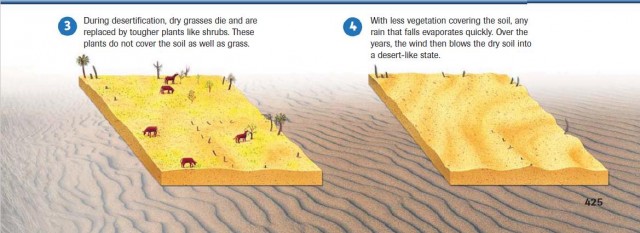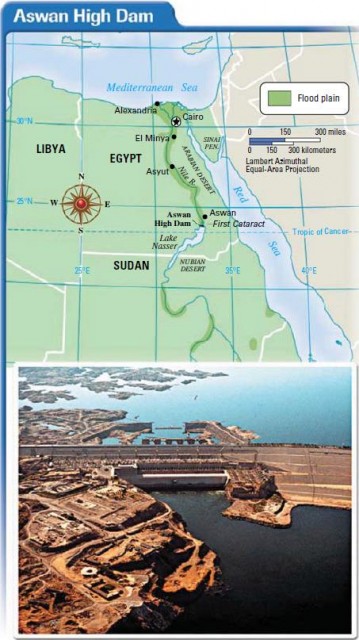Africa: Human–Environment Interaction
A HUMAN PERSPECTIVE Akierou Awe lives in a mud-brick house in Nigeria's Niger delta, a region that contains most of Nigeria's oil. On the morning of July 10, 2000, Awe's four sons had been collecting fuel from a leaking pipeline to help scrape out a living in this poverty-stricken region. They hoped to resell the fuel for more than the going rate of 21 cents a quart. Suddenly, an explosion shook the area, and a fire spread along a mile-long stretch of the pipeline. The blast killed more than 300 people, including three of Awe's sons. This accident is one of many in the recent past that have claimed the lives of hundreds of Nigerians. Nigeria has become one of the top oil producers in the world, but at the cost of thousands of lives and major environmental ruin in the region.
Desertification of the Sahel
Sahel means “shore of the desert” in Arabic. You can see from the physical map on page 403 that the Sahel is a narrow band of dry grassland that runs east to west along the southern edge of the Sahara. People use the Sahel for farming and herding. Since the 1960s, the desert has spread into the Sahel. This shift of the desert is called desertification. Desertification is an expansion of dry conditions into moist areas that are next to deserts. Normally, it results from nature's long-term cycle, but as you can see in the illustration below, human activity is speeding up the process.
HUMAN CAUSES OF DESERTIFICATION
Geographers and other scientists have identified several human activities that increase the pace of desertification. For example, allowing overgrazing of vegetation by livestock exposes the soil. Animals also trample the soil, making it more vulnerable to erosion.
Farming also increases the pace of desertification. When farmers clear the land to plant crops, they expose the soil to wind, which can cause erosion. In addition, when farmers drill for water to irrigate crops, they put further stress on the Sahel. Widespread drilling and more irrigation increase salt levels in the soil, which prevent the growth of vegetation.

Increasing population levels are an indirect cause of desertification. More people require more food. As a result, farmers continue to clear more land for crops, burn more wood for fuel, and overfarm the land they already have.
RESULTS OF DESERTIFICATION
Desertification has affected many parts of Africa. For example, large forests once existed around Khartoum, Sudan. In addition, desertification is slowly destroying a tropical rain forest around Lake Chad in the southern edge of the Sahel. Slowing desertification is difficult. Some African countries have increased tree planting and promoted more efficient use of forests and farmland in hopes of slowing the process.
Harming the Environment in Nigeria
Another environmental issue concerns the discovery of oil in Nigeria in 1956. Rich oil deposits in the Niger delta made Nigeria one of Africa's wealthiest countries. However, in drilling for oil, the Nigerian government and foreign oil companies have often damaged the land and harmed the people living in the Niger delta.
A MAJOR OIL PRODUCER
Nigeria is the sixth leading oil exporter in the world. Two million barrels are extracted each day, much of it shipped to the United States. Oil accounts for 80 to 90 percent of Nigeria's income. During the 1970s, high oil prices made Nigeria one of the wealthiest nations in Africa. As a result, the government borrowed heavily against the future sale of its oil. However, oil prices eventually fell, and the Nigerian government owed millions of dollars to other nations, including the United States. Mismanagement, poor planning, corruption, and a decline in oil prices left Nigeria poorer than before the oil boom.

DESTROYING THE LAND AND PEOPLE
The damage caused by oil companies and the Nigerian government has been severe. More than 4,000 oil spills have occurred in the Niger delta over the past four decades. Cleanup operations have been slow and sometimes non-existent. Fires often resulted, causing acid rain and massive deposits of soot, and people in the region contracted respiratory diseases. In addition, between 1998 and 2000, oil pipeline explosions killed more than 2,000 people—including three of Akierou Awe's sons.
Many of these explosions were not accidents but were caused intentionally. Bandits, in cooperation with corrupt government officials and the military, drain fuel from the pipelines and then resell it. In 1999, these bandits damaged about 500 pipelines. Once the bandits finish draining oil, local villagers arrive.
They use small cans to collect any spilled oil and then sell it.
A NEW START
In May 1999, Olusegun Obasanjo became Nigeria's new president. Although a former Nigerian military leader himself, he has distanced himself from the armed forces. He has started many economic reforms and fired corrupt government officials. Now he faces the task of finding ways for Nigeria to benefit from oil.

Controlling the Nile
Egypt faces environmental challenges caused by another resource—water.
Throughout history, the Egyptians have tried to control the floodwaters of the Nile River. Ancient Egyptians built canals and small dams. In spite of these efforts, though, the people still experienced cycles of floods and droughts. To solve these problems, Egyptians completed the first Aswan Dam on the Nile in 1902, which quickly became outmoded.
THE ASWAN HIGH DAM
Four miles upriver from the first Aswan Dam, the Egyptians cut a huge channel through the land beside the Nile River. The builders used the rocks from the channel as a base for their new creation—the Aswan High Dam—which was completed in 1970. Lake Nasser, which Egypt shares with Sudan, is the artificial lake created behind the dam. It stretches for nearly 300 miles.
The dam gives farmers a regular supply of water. It holds the Nile's floodwaters, releasing them as needed so that farmers can use the water effectively for irrigation. As a result of the dam, farmers can now have two or three harvests per year rather than one.
Irrigation canals even keep some fields in continuous production through the use of artificial fertilizers. The dam has increased Egypt's farmable land by 50 percent. The dam has also helped Egypt avoid droughts and floods.
PROBLEMS WITH THE DAM
Though the dam has provided Egypt with many benefits, it has also created some problems. During the dam's construction, many people had to be relocated, including thousands of Nubians, whose way of life was permanently changed. In addition, one of ancient Egypt's treasures, the temples at Abu Simbel, had to be moved. Other smaller ancient treasures could not be saved and now lie at the bottom of Lake Nasser.
The dam also decreased the fertility of the soil around the Nile. First, the river no longer deposits its rich silt, or sediment, on the farmland. Farmers must now rely on expensive artificial fertilizers to enrich the soil. Second, this year-round irrigation has resulted in a rising water table in Egypt. As a result, salts from deep in the earth have decreased the fertility of the soil. Before the dam was built, floodwaters flushed out the salt. Now expensive field drains have to be installed.
Rates of malaria and other diseases have increased due to greater numbers of mosquitos, which thrive in the still waters of Lake Nasser and the irrigation canals. Furthermore, because Lake Nasser holds the floodwaters, Egyptians lose millions of gallons of fresh water every year to evaporation. Measuring the success of the Aswan High Dam is difficult. For all the ways it has helped Egyptians, it has also created new problems.